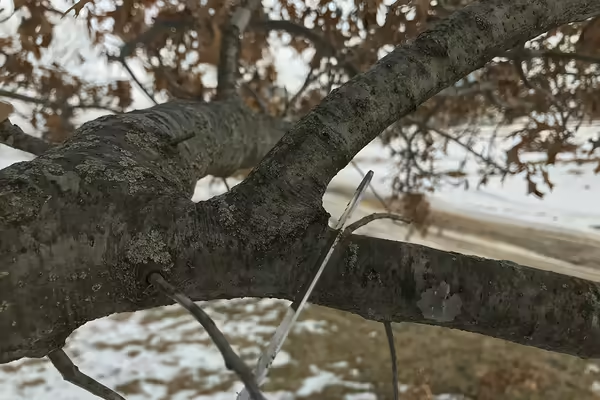
URBANA, Ill. — To stay healthy, sometimes trees need a little help in the form of a trim. Pruning is an essential maintenance activity to promote tree health, safety, and aesthetics. Since trees are large, long-living plants in our landscape, pruning throughout the life of a tree can have a significant impact on how it functions in the landscape and how long it survives. Pruning while a tree is young can have exponentially beneficial results for long-term tree health, maintenance requirements, and beauty.
Because no two trees are the same, pruning is both an art and a science. Research has helped advance our understanding of tree physiology and response to pruning activities, improving techniques and outcomes. Deciding which pruning cuts to make depends on many unique factors, such as plant species, age, reasons for pruning, and desired outcome.
Before making a pruning cut, it is important to assess the entire tree and surrounding site conditions that influence the tree. It is also critical to determine your objectives for pruning. Every pruning cut, large or small, should have an explicit purpose and advance the tree toward the identified goals.
There are many reasons for pruning a tree, including safety, health, and appearance.
Prune for safety
Pruning for safety involves pruning branches that interfere with human activities or pose a threat. You can improve safety by removing limbs that block traffic sight lines or branches over sidewalks and trails that impede pedestrian traffic. Additionally, broken limbs in the canopy pose a fall risk and should be removed.
Prune for tree health
Pruning for health includes the removal of branches that cross or rub with others to minimize self-wounding. Pruning trees for structural integrity is an effective way to increase safety and promote tree health. One of the most common structural concerns is co-dominant leaders. Trees with two or more dominant leaders develop structurally weak branch angles that threaten to split under the weight of the canopy. Corrective pruning should be done to encourage a single leader. Pruning dead or diseased limbs removes disease pathogens from the tree and should always be an objective of a pruning regime.
Prune for appearance
Pruning for aesthetics turns the focus toward human preferences. The desired appearance is a subjective analysis, however, pruning decisions made for looks should still adhere to proper pruning techniques and prioritize the health and safety of the tree.
When should trees be pruned?
In the Midwest, the late dormant season is the optimal time to prune deciduous trees. While dormant, deciduous trees have shed their leaves, making it easier to assess the overall form of the tree and make pruning choices related to structural integrity easier. By pruning just before spring, trees can better allocate energy resources toward producing leaves that will remain on the tree throughout the growing season. They also dedicate energy to sealing the wounds created by pruning. Pruning branches full of leaves diminishes the tree's capacity to photosynthesize and replenish carbohydrate reserves. Finally, pruning in later winter means that opportunistic insects and disease pathogens are also dormant, reducing the risk of infection.
How to make a pruning cut
Once you decide a pruning cut is necessary, proper technique is required.
Preserving the branch bark collar is essential to wound sealing. The branch bark collar is a swollen or raised strip of bark at the intersection of the branch and the trunk of a tree. Pruning practices of the past that include flush cuts removed the branch bark collar and are no longer recommended.
Make pruning cuts just outside the branch bark collar and have a smooth finish. If larger branches are being removed, a three-point pruning cut is recommended to avoid ripping the bark as the limb falls during the pruning activity under the weight of the branch.
Pruning is an ongoing maintenance activity, and trees should be assessed annually for pruning needs. Being consistent with assessment and action can help minimize the workload for pruning and minimize stress response in trees. If mature trees need pruning, it is best to consult with a professional arborist. Safety should always be the top priority. Pruning activities that require lift equipment or power tools should be performed by a professional arborist.
Emily Swihart is an Illinois Extension horticulture educator for Henry, Mercer, Rock Island, and Stark counties. Gardeners Corner is a quarterly newsletter from gardening experts around the state. Each issue highlights best practices that will make your houseplants, landscape, or garden shine in any season. Join the Gardener’s Corner email list at go.illinois.edu/GCsubscribe for direct access to timely tips.
PHOTO CAPTION: The photos in this article are available to download for media use. Photos by Emily Swihart, Illinois Extension. Make pruning cuts just outside the branch bark collar that have a smooth finish. For larger branches, a three-point pruning cut is recommended to avoid ripping off bark.
Illinois Extension leads public outreach for University of Illinois by translating research into action plans that allow Illinois families, businesses, and community leaders to solve problems, make informed decisions, and adapt to changes and opportunities. Illinois Extension is part of the University of Illinois Urbana-Champaign College of Agricultural, Consumer and Environmental Sciences.